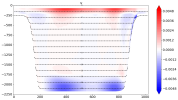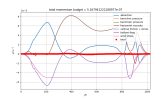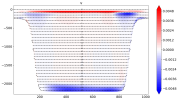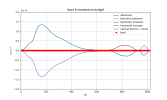What version of the code are you using?

 github.com
github.com
Describe your problem or question:
I tried to build a double slope channel case with a westward wind stress based on the input file of Neverworld2, the wind stress is 0 at northern and southern boundaries and increases as a sine function to a constant value of 0.05N/m^2 over the basin. I tried 15 layers and 30 layers, the densities of each layer in 15 layers case follow Neverworld2 and they are interpolated to 30 layers.
The contours shown are plotted in z coordinates. There is a large time and zonal averaged meridional velocity over the northern shelf in the subsurface of 30 layers case but it is considerably smaller in 15 layers. I also plotted the total momentum budget, the momentum budget of the 3th layer in 15 layers case and the 6th layer in 30 layers case, where the 30 layers case showed a large horizontal viscosity friction (the "diffu" diagnostic) over the northern shelf.
I don't understand why the change of vertical coordinate leads to the horizontal friction difference. The "Ahh" diagnostic in two cases are of the same order so the large friction should be mainly caused by the fourth order laplacian of u. I tried changing the depth of mixed layer and biharmonic Smagorinsky constant but they doesn't make a large difference (unless decrease the biharmonic Smagorinsky constant for more than an order of magnitude). Please tell me which configurations or source code should I check.






GitHub - NOAA-GFDL/MOM6-examples: Example configurations for MOM6 and SIS2
Example configurations for MOM6 and SIS2. Contribute to NOAA-GFDL/MOM6-examples development by creating an account on GitHub.
Describe your problem or question:
I tried to build a double slope channel case with a westward wind stress based on the input file of Neverworld2, the wind stress is 0 at northern and southern boundaries and increases as a sine function to a constant value of 0.05N/m^2 over the basin. I tried 15 layers and 30 layers, the densities of each layer in 15 layers case follow Neverworld2 and they are interpolated to 30 layers.
The contours shown are plotted in z coordinates. There is a large time and zonal averaged meridional velocity over the northern shelf in the subsurface of 30 layers case but it is considerably smaller in 15 layers. I also plotted the total momentum budget, the momentum budget of the 3th layer in 15 layers case and the 6th layer in 30 layers case, where the 30 layers case showed a large horizontal viscosity friction (the "diffu" diagnostic) over the northern shelf.
I don't understand why the change of vertical coordinate leads to the horizontal friction difference. The "Ahh" diagnostic in two cases are of the same order so the large friction should be mainly caused by the fourth order laplacian of u. I tried changing the depth of mixed layer and biharmonic Smagorinsky constant but they doesn't make a large difference (unless decrease the biharmonic Smagorinsky constant for more than an order of magnitude). Please tell me which configurations or source code should I check.






